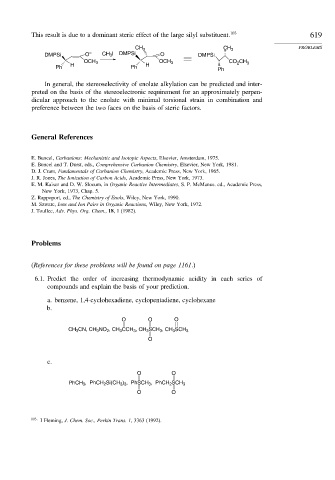Page 637 - Advanced Organic Chemistry Part A - Structure and Mechanisms, 5th ed (2007) - Carey _ Sundberg
P. 637
This result is due to a dominant steric effect of the large silyl substituent. 103 619
CH 3 CH 3 PROBLEMS
DMPSi O – CH 3 I DMPSi O DMPSi
2
OCH 3 OCH 3 CO CH 3
H H
Ph Ph
Ph
In general, the stereoselectivity of enolate alkylation can be predicted and inter-
preted on the basis of the stereoelectronic requirement for an approximately perpen-
dicular approach to the enolate with minimal torsional strain in combination and
preference between the two faces on the basis of steric factors.
General References
E. Buncel, Carbanions: Mechanistic and Isotopic Aspects, Elsevier, Amsterdam, 1975.
E. Buncel and T. Durst, eds., Comprehensive Carbanion Chemistry, Elsevier, New York, 1981.
D. J. Cram, Fundamentals of Carbanion Chemistry, Academic Press, New York, 1965.
J. R. Jones, The Ionization of Carbon Acids, Academic Press, New York, 1973.
E. M. Kaiser and D. W. Slocum, in Organic Reactive Intermediates, S. P. McManus. ed., Academic Press,
New York, 1973, Chap. 5.
Z. Rappoport, ed., The Chemistry of Enols, Wiley, New York, 1990.
M. Szwarc, Ions and Ion Pairs in Organic Reactions, Wiley, New York, 1972.
J. Toullec, Adv. Phys. Org. Chem., 18, 1 (1982).
Problems
(References for these problems will be found on page 1161.)
6.1. Predict the order of increasing thermodynamic acidity in each series of
compounds and explain the basis of your prediction.
a. benzene, 1,4-cyclohexadiene, cyclopentadiene, cyclohexane
b.
O O O
CH 3 CN, CH 3 NO 2 , CH 3 CCH 3 , CH 3 SCH 3 , CH 3 SCH 3
O
c.
O O
PhCH 3 , PhCH 2 Si(CH 3 ) 3 , PhSCH 3 , PhCH 2 SCH 3
O O
103
I Fleming, J. Chem. Soc., Perkin Trans. 1, 3363 (1992).

